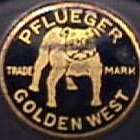You may get more answers than you asked on this thread.
Thumb is always the best brake, and has always been the most important part of baitcasting.
Most antique baitcasters had spindle end tension, comparable to "cast control" on modern reels - tightening the end cap bearings against the spool spindle.
The highest grade antique benchmade reels, Meek, Talbot, and Jack Welch Heddon, instead used oil whirl in the spindle bushings for backlash control, which behaves much like a centrifugal brake.
A separate adjustable brake on antique reels was often a wool pad that you dialed into the spool flange. The first reactive brake was 1911, South Bend ABL, which used a bail over the line, allowing line tension to guide and modulate the wool pad. Though not a great distance caster, South Bend ABL could be adjusted to an absolute no-thumbs reel.
The first centrifugal brake patent was 1915, Redifor, which consisted of two metal pawls on the spool flange that rubbed the frame - it worked too well at braking, and they're not very good casters. But if you check the thread I linked, they looked really good.
The 1918 Douglas patent was far ahead of its time, offering freespool by disengaging the pinion gear from both the drive gear and the spool, anti-reverse in the same mechanism, and a functional level wind that was also separate from the spool. The subtle casting brake consisted of a cam-loaded fine-wire spring that acted on the spool drum.
The first good freespool and the centrifugal brake that we all recognize was the Abu Ambassadeur, designed in the late '40s, and first produced in 1952.
The mag brakes that you remember, appearing in the 1980s, didn't do a lot compared to modern versions.
The antique Meek, Talbot, and Heddon reels that I first mentioned were modified and used almost exclusively for tournament distance casting right through the 1970s (and later), with (stripped down) Ambassadeurs gradually working their way into the competition. Abu's first purpose-built tournament casting reel (CT) had a short run in the 1970s, a second limited version in 1980. Later CT versions with ball bearings have continued production since 1991, and with good mag brakes beginning 1995.










